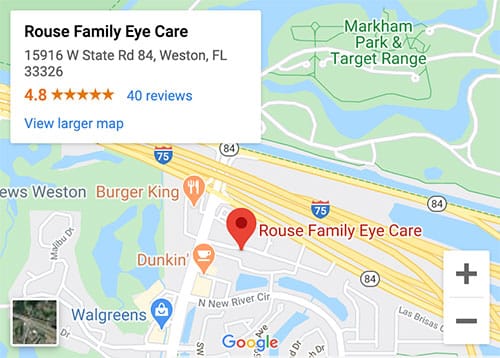Keratoconus is an eye condition in which the clear, dome-shaped surface of the eye bulges outward and becomes cone-shaped. This bulging of the surface of the eye, known as the cornea, affects eyesight. Medical researchers have not yet determined the exact causes of keratoconus, but they think certain factors can increase the risk of keratoconus. Early diagnosis and treatment can help address vision problems associated with keratoconus, and in some cases, can help slow the progression of the eye problem. Light passes from the outside world through the cornea and into the eye, where it strikes a light-sensitive layer of tissue at the back of the eye, known as the retina. Along with the eye’s lens, the cornea helps focus the light so that it hits at a precise location on the retina to create clear vision. In keratoconus, bulging changes the shape of the cornea and brings the ray of light out of focus, which causes distorted vision.
- The condition can occur in one or both eyes, and it typically develops when a person is in his or her teens or 20s. Genetic and environmental factors can increase the risk of developing keratoconus. About one in ten people with keratoconus have a parent with the condition. Risk factors for keratoconus include: Family history of keratoconus
- Rubbing the eyes vigorously
- Having certain health conditions, such as retinitis pigmentosa, Ehlers-Danlos syndrome, Down syndrome, hay fever and asthma
Keratoconus is progressive condition, which means the bulging of the cornea worsens over time. It may progress for 10 to 20 years and then, for some patients, slow down. In a small number of cases, the cornea swells to cause a sudden and significant decrease in vision. Advanced keratoconus can lead to scarring of the cornea, particularly where the cone forms, which causes worsening vision problems.
Signs and Symptoms of Keratoconus
The signs and symptoms of keratoconus change as the bulging of the cornea progresses. Keratoconus causes progressive nearsightedness and irregular astigmatism, both of which cause blurred vision. A misshapen cornea can also cause sensitivity to glare and bright lights. In many cases, people with keratoconus need a new eyeglass prescription each time they have a vision checkup. People with keratoconus who experience a sudden vision problem should see an eye doctor right away. Those never diagnosed with keratoconus should see an eye doctor if their eyesight is worsening rapidly; the eye doctor will look for signs of astigmatism and keratoconus.
Diagnosis of Keratoconus
Diagnosis and treatment of keratoconus starts with an eye exam and review of the patient’s family history. The eye doctor may conduct tests to evaluate the shape of the cornea. These tests include:
Eye refraction
The eye doctor uses special equipment to check for vision problems
Slit-lamp examination
The eye care professional directs a vertical beam of light onto the surface of the eye and uses a low-powered microscope to evaluate the shape of the cornea and look for other problems affecting the eye.
Keratometry
In this procedure, the eye doctor determines the basic shape of the cornea by projecting a circle of light onto the cornea and measuring its reflection.
Computerized corneal mapping
An eye doctor can perform special computerized tests that record images of the cornea and create a detailed shape map of its surface. These tests can also measure the thickness of the patient’s cornea.
Treatment of Keratoconus
Keratoconus treatment depends largely on a patient’s symptoms. Treatment changes as keratoconus progresses. Eyeglasses can correct vision for patients with mild symptoms, for example, and for those in the early stages of keratoconus. Specially made soft contact lenses may also correct vision.
Gas permeable contact lenses can help keep vision in focus later on, as the cornea bulges more. These special hard lenses work by replacing the irregular corneal shape of keratoconus with a smooth, uniform surface that focuses light well. While effective, these hard contact lenses can be uncomfortable, so some eye doctors recommend that patients “piggyback” contact lenses by wearing a gas permeable contact lens on top of a soft lens.
Other special lenses, such as hybrid contact lenses that combine a soft and a hard lens, and large-diameter scleral lenses that cover the entire white part of the eyeball, are now available. Eye surgeons can also implant arc-shaped inserts into the cornea to reshape the front surface of the eye for clearer vision. Techniques, such as topography-guided conductive keratoplasty (CK), can help smooth irregularities in the surface of the cornea. Advanced keratoconus may require a corneal transplant.
Scleral Lenses for Keratoconus
For patients diagnosed with keratoconus due to irregular corneas, scleral lenses are considered to be the preferred method of treatment. Scleral lenses are rigid, gas-permeable lenses that rest fully on the white part of the eye known as the sclera. These uniquely designed lenses sort of dome over the cornea, which can be especially sensitive among people with keratoconus.
Several advantages come along with scleral lens treatment, such as heightened visual acuity and better comfort for the patient. However, the lenses are also more stable than traditional contact lenses and may be more effective for issues with astigmatism. Contact our office for more information about scleral lenses in Weston, FL.
For more information on keratoconus, contact your eye care professionals at Rouse Family Eye Care.

954-384-6200
